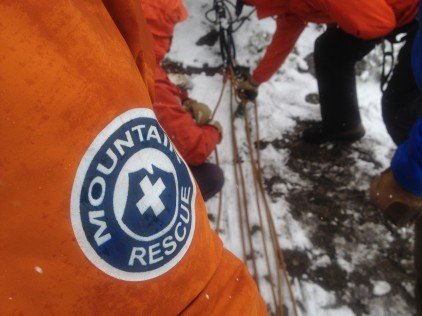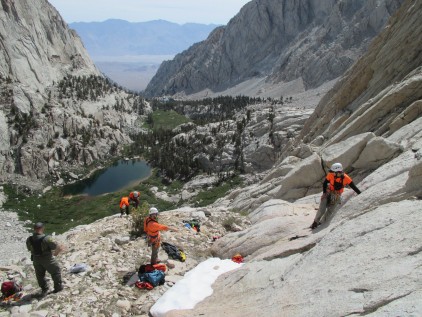If you have an emergency, call 911.
Traveling in the wilderness presents risks. Rescues can be costly, dangerous, and difficult. Though SAR teams will do everything possible to assist you, YOU ARE NOT GUARANTEED A RESCUE.
Please take a moment to read through these safety tips and rescue procedures before heading into the wilderness. First we will go over what to do before your trip to help avoid trouble later; then we will talk about what to do if you get lost or have an injury while on Mt Whitney.
Plan for it to be more than expected. By the time you get to the trail, you’ve probably already put a lot of time and planning into the trip, and you want everything to work out well. Who knows, maybe with a little planning and preparation you can even assist someone else in trouble on the trail!
This is not meant to be a comprehensive guide, as there are multitudes of books written on backcountry travel, hiking, mountaineering, and climbing. The goal is to get you thinking and preparing.
Part 1: The three essential concepts before your trip are Planning, Preparation, and Communication.
Planning:
Research and choose your route, obtain maps or other location information, find out things like how steep the terrain is, where water sources and campsites are, and what the climate is like. As your trip date approaches, pay attention to short and long term weather forecasts.
Know what sort of gear you will need and how you will get it. A lot of gear can be rented or borrowed, and while certain items may seem excessive at home, they could come in very handy on the trail. Remember, you are preparing for ALL scenarios, not just the perfect scenario. Things often change a lot on the trail, whether it’s the weather around you or your mental state as the exhaustion develops. Lists of the “ten essentials” are a good place to start. These lists suggest the top ten items that will help you stay alive in the backcountry, or at least make your trip more comfortable. Inyo SAR encourages you to take these items every time you go out: plenty of water, food, a flashlight or headlamp, sunscreen, first aid kit, your own medicine, hat, sunglasses, rain jacket and warm layers, watch, knife. Other items might include a map, emergency shelter, electrolyte tablets, a compass, pen and paper, a whistle, and appropriate footwear. Also remember, cotton is often a poor choice for outdoor apparel as if it gets wet, it will only make you colder.
Make sure your route requires skills that you are prepared to handle. For example, if planning to do the Mountaineers Route, on Mt Whitney, be aware that route finding and scrambling are involved, rockfall is a constant danger and a helmet is advisable, and do not hike on a talus slope directly beneath another hiker as it increases your chance of being hit by rock. Also, approaching the mountain from the east side may limit your visibility for spotting storms that are developing on the west side and you could be surprised at a higher altitude and thus have a greater risk level for being struck by lightning.
Preparation:
Learn about altitude sicknesses and how to recognize them, and prepare yourself physically for your hike with both strength and cardiovascular workouts. The more fit you are, the more able you will be to take care of yourself or recognize when things may not be going right, and the less likely you are to injure yourself. Train, train, train!
Gather all of your gear and use a checklist so you don’t forget anything. Obtain the proper permits. Learn about how to manage human waste in the wilderness.
Seek out knowledge from others. Learn any specialized skills you may need for your trip and practice them before-hand. Talk to others to gather information about your route or read trip reports or books on the route or area.
Communicate:
Before, during, and after. Before you go, tell someone about your plans. Be very specific. Include you intended route, start and return dates (and times if appropriate), what gear you have with you and what your gear looks like (clothing colors, pack color, shoe type), who to call if you don’t return on time, and your own cell phone number. Other information that SAR teams like to know if a call does happen include a recent photo, what the sole of your shoe is like, your vehicle and plate number, and a piece of clothing or gear that has your name on it.
During your trip, communicate with your partner(s) about how they are feeling, what risks they are observing, and how things are going. Make sure others are eating and drinking water all along the way. Take rests so as to not wear out too soon. If you planned a trip with your partner, don’t leave your partner. If you must separate, be very clear about how, when, and where to meet, and what the expectations are.
To contact the outside world in an emergency, you should know where ranger stations are located. Many places in Inyo County have cell phone coverage, so take your phone (but keep it off to save battery life). Head to high locations with views of the Owens Valley to find coverage. A satellite phone, while expensive, can provide excellent communication. Then there are personal locator beacons, such as the SPOT device. If you take one of these, know that from the standpoint of the rescuer, these devices have very limited usefulness. When combined with other forms of communication, the are excellent. However, alone they tell us very little information. Only activate them if you have a true emergency, and do not rely on them alone to signal help.
After your trip, let your contact know that you made it out safe. Discuss how the trip went with your partner and what could have gone better or worse. Reflect on both good and bad decisions made. These little details may help a whole lot on your next trip.
Part 2: What to do if things go wrong:
Any number of dangerous situations could occur during your trip. Most incidents are caused by events related to weather, illness, injury, or fatigue. The best way to handle these is to prevent them, but sometimes things still go wrong or are a surprise. Every wilderness emergency is unique and we could not begin to hope to address each scenario that could arise. However, here are some tips that may help you to plan a course of action to help someone or yourself out, as well as things that will help a Search and Rescue team to help you.
-
Before you go: Tell someone before you go where you are going and when you expect to return.
- Don’t Panic. Stay calm, assess the situation. Look for hazards, and make sure you are safe.
- If you get separated from your group, yell or whistle then stop and listen.
- If you are lost, STOP. Learn your surroundings and take note. This is now your known point, make sure you can identify it from a distance, then start exploring carefully. At times you are better off staying put, at other times you may want to move, but be prepared to recognize when to turn around and return to your known point.
- Use self awareness. Your pulse can be a good indicator. Do not make hasty decisions; instead, slow down and make a plan of action. Prepare for night time before night falls so you are not caught without shelter.
- If you can’t find your way out on your own, stay in an open area for visibility and try to make a signal. Bright gear or clothing, flashlights, flare, and sometimes contained fires make good signals, as well as creating artificial patterns on the ground such as tracks across snow.
- If a person in your party is missing, search for him or her (without getting yourself lost – make a plan). Try to preserve tracks and belongings. See if there are any witnesses. Send for help with a complete and accurate description.
- If someone is injured or ill and needs help, send for help with a complete and clear report. This report should include:
- exact location
- what happened
- description of the injury or illness
- approximate age and weight of the individual
- any important medical history (diabetic, allergies, heart condition)
- level of consciousness
- ability to walk
- any other important notes about the person or situation that may help a SAR team to access, treat, and evacuate the victim.
Self Rescue:
The most important aspect of self rescue is to prevent the need for a rescue. Stop and rest before you get tired. Give your body time to digest food before moving too much. Fix small problems while they are small. Choose your hiking times and weather and route with care.
Think about what you can do to help yourself or your group. It could take a long time for a SAR team to reach you. Are you able to help the patient? Do you know where a missing person could have gone? Can you self-evacuate? Consider all of your options, and take action.
The Inyo SAR team encourages you to get out into the wilderness and have a great time, just be prepared. Have a great hike and stay safe!


